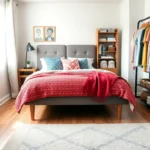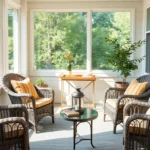Long living rooms can feel like decorating puzzles that leave many homeowners scratching their heads. Whether you’re dealing with a narrow rectangular space or an expansive open-concept area that seems to stretch on forever, we understand the unique challenges these rooms present. The key isn’t fighting against your room’s proportions – it’s learning how to make them work in your favor.
We’ve discovered that the most successful long living room designs create distinct zones while maintaining visual flow throughout the space. From strategic furniture placement to clever lighting tricks, there are countless ways to transform your lengthy room into a functional and stylish haven that feels perfectly proportioned.
Ready to unlock your long living room’s full potential? We’ll share proven design strategies that’ll help you create a space that’s both beautiful and incredibly livable, no matter how challenging your room’s dimensions might seem.
Create Distinct Zones With Strategic Furniture Placement
Strategic furniture arrangement transforms long living rooms into functional multi-use spaces that feel intentional rather than awkward. We’ll show you how to divide your elongated room into distinct areas without sacrificing the open feel.
Use Area Rugs to Define Separate Spaces
Anchor each zone with appropriately sized rugs to create visual boundaries throughout your long living room. We recommend using 8×10 foot rugs for seating areas and 5×7 foot rugs for reading nooks or conversation spaces. Position rugs so that front furniture legs rest on them while back legs remain on the floor.
Layer different rug textures and patterns to add depth while maintaining cohesion across zones. Choose complementary colors that tie your spaces together, such as matching accent tones or similar neutral palettes. Avoid identical rugs, which can make your room feel repetitive rather than thoughtfully designed.
Create walking paths between rugged areas by leaving 18 to 24 inches of bare floor space. This spacing prevents your long living room from feeling cramped while clearly delineating where one zone ends and another begins.
Position Sofas to Create Natural Room Divisions
Float your primary sofa in the center of the room instead of pushing it against a wall to instantly create two distinct spaces. Position the sofa perpendicular to the room’s length, allowing for a conversation area on one side and a secondary function space on the other.
Add a second seating piece facing away from the main sofa to reinforce the division between zones. Consider placing a loveseat, accent chairs, or a bench at the opposite end of your long living room to create a reading area or workspace.
Use sofa backs as natural room dividers by positioning them strategically to block sightlines between different activity areas. This technique works particularly well when you want to separate a TV watching zone from a quieter conversation space.
Add Console Tables as Functional Dividers
Place a console table behind your floating sofa to create storage and display space while reinforcing the room’s division. Choose tables that are 12 to 15 inches deep to avoid blocking walkways, and select heights that align with your sofa back.
Style console tables with lamps and decorative objects to make them feel intentional rather than like afterthoughts. We suggest adding table lamps for ambient lighting, books or magazines for accessibility, and plants or artwork for visual interest.
Consider console tables with open shelving to maintain visual flow between zones while providing functional storage. These pieces serve double duty as room dividers and display areas for baskets, books, or decorative accessories that enhance your long living room’s overall design.
Maximize Natural Light Throughout the Extended Space
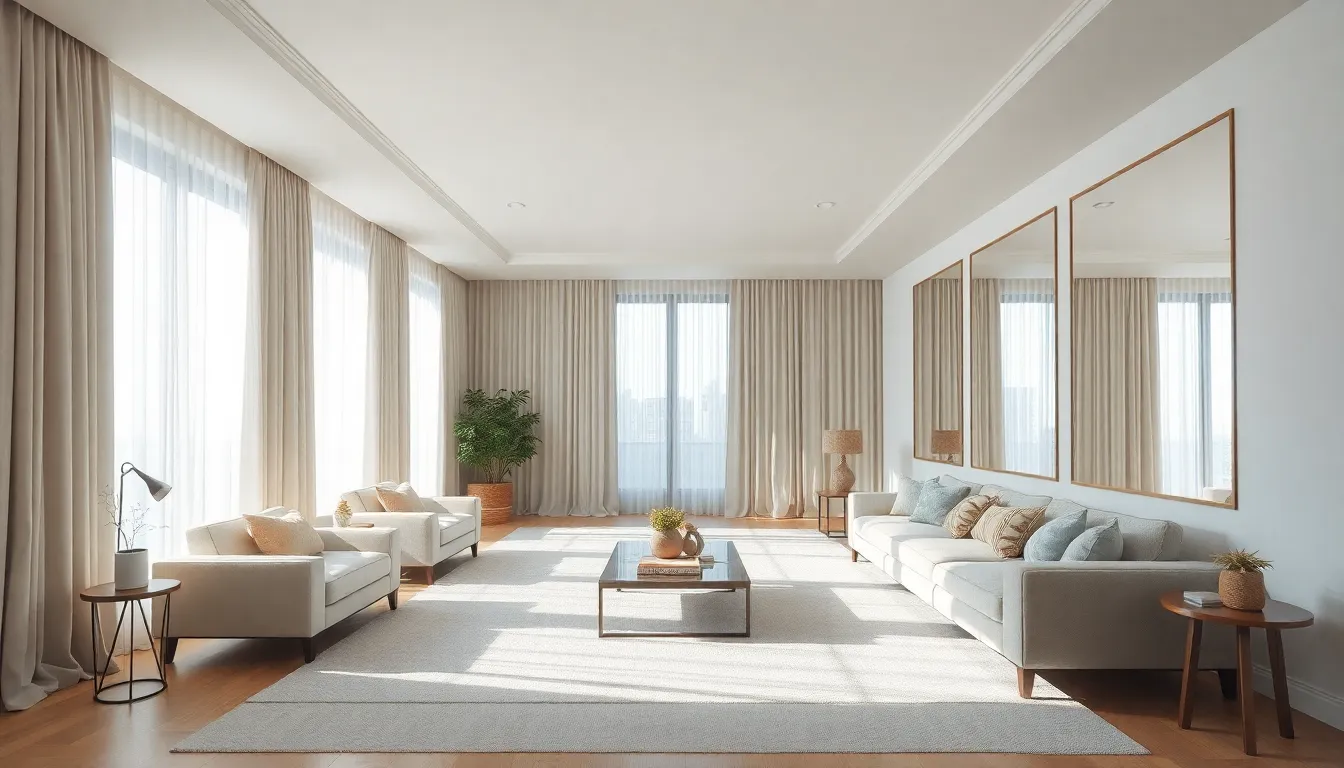
Lighting transforms how we perceive space, making it especially crucial in long living rooms where natural illumination can either enhance or diminish the room’s proportions.
Install Floor-to-Ceiling Curtains for Height Drama
Floor-to-ceiling curtains create vertical emphasis while maximizing available natural light in extended spaces. We recommend mounting curtain rods as close to the ceiling as possible, extending them several inches beyond the window frame on each side. This technique visually stretches the wall height and allows maximum light penetration when curtains are drawn open.
Choose lightweight fabrics like linen or cotton voile that filter light beautifully without blocking it entirely. Hang curtains in light neutrals such as white, cream, or pale gray to reflect rather than absorb incoming sunlight. When selecting curtain width, we suggest panels that are 1.5 to 2 times wider than your window to create elegant folds while maintaining the dramatic height effect.
Use Mirrors to Reflect Light Down the Length
Mirrors strategically placed along your long living room’s length amplify brightness and create the illusion of expanded width. Position large mirrors opposite windows to bounce natural light deeper into the space, effectively doubling the illumination throughout the extended area. We find that placing mirrors at different heights creates ever-changing light reflection patterns.
Consider installing a series of smaller mirrors down one wall to create a gallery effect while maximizing light distribution. Leaning oversized floor mirrors against walls provides flexibility to adjust positioning based on seasonal sun angles. Mirrored furniture pieces like coffee tables or side tables contribute additional reflective surfaces without overwhelming the space.
Choose Light-Colored Paint for Walls and Ceilings
Light-colored paint enhances airiness and openness, making long living rooms feel less confined and more spacious. We recommend using the same light shade on both walls and ceilings to create seamless visual flow that eliminates visual breaks. Pure whites, warm creams, and soft grays reflect the most light while maintaining sophistication.
Paint finishes matter significantly for light reflection. Eggshell or satin finishes provide subtle sheen that bounces light effectively without creating harsh glare. Avoid flat paints in long spaces as they absorb rather than reflect precious natural light. Consider using slightly different tones of the same color family to add subtle depth while maintaining the light-improving benefits throughout your extended living area.
Design a Balanced Focal Point at Each End
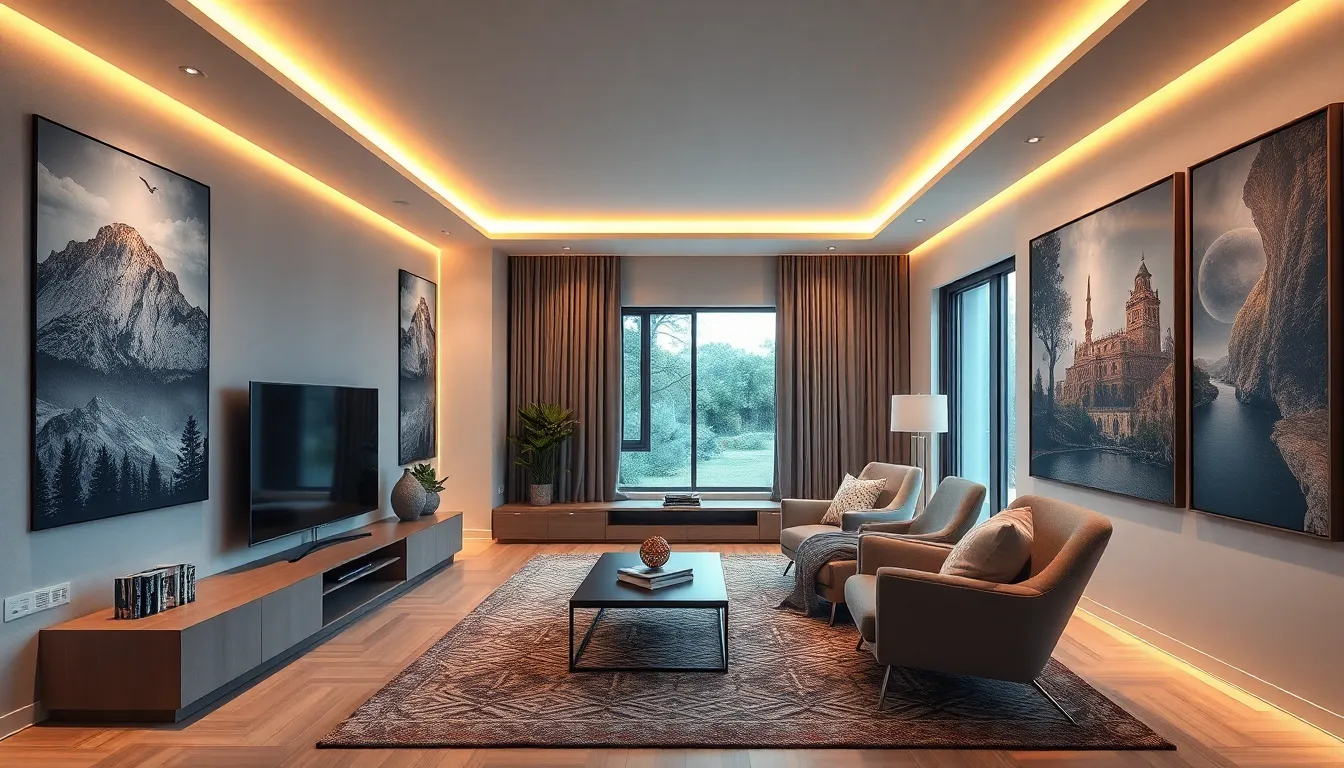
Balanced focal points prevent your long living room from feeling like a corridor by creating visual anchors that draw the eye to both ends. We recommend establishing two distinct activity zones that complement each other while maintaining the room’s overall design harmony.
Create a Media Wall at One End
Media walls transform one end of your long living room into an entertainment hub that anchors the entire space. Installing a large screen TV with surrounding built-in shelving creates both function and visual weight that grounds this zone effectively.
Sectional sofas positioned facing the media wall establish the primary seating area while defining the entertainment zone’s boundaries. We suggest choosing an L-shaped or U-shaped sectional that can accommodate your family’s viewing needs without overwhelming the space.
Sound systems integrated into the media wall design enhance the entertainment experience while maintaining clean aesthetics. Concealed speakers and wire management systems keep the area looking polished and professional.
LED lighting strips behind the TV or within built-in shelving add ambient lighting that reduces eye strain during viewing. These accent lights also create visual depth and make the media wall feel more substantial in the room’s proportions.
Establish a Reading Nook at the Opposite End
Reading nooks at the far end of your long living room create a quiet retreat that balances the active media zone. Positioning a comfortable armchair or loveseat near a window maximizes natural light for reading while establishing this zone’s purpose.
Floor lamps with adjustable lighting provide task illumination for reading while adding vertical elements that enhance the room’s proportions. We recommend choosing lamps with warm LED bulbs that create a cozy atmosphere without competing with the media area’s lighting.
Tall bookshelves flanking the seating area create visual weight that matches the media wall’s presence while providing storage for books and decorative objects. Built-in or freestanding bookcases work equally well depending on your budget and design preferences.
Side tables positioned next to reading chairs offer surfaces for beverages and books while completing the nook’s functionality. Choose tables that complement your overall design scheme while providing adequate storage for reading essentials.
Use Large Artwork to Anchor Each Zone
Large artwork serves as visual anchors that define each zone while preventing the long living room from feeling empty or unfinished. Statement pieces measuring at least 36 inches wide create sufficient visual impact to balance your room’s proportions effectively.
Gallery walls featuring multiple coordinated pieces can substitute for single large artworks when budget constraints exist. We recommend maintaining consistent framing and spacing between pieces to create cohesive visual impact that rivals single statement works.
Color coordination between artwork and each zone’s furnishings creates intentional design flow that unifies the long living room’s separate areas. Selecting pieces that incorporate colors from nearby furniture or accessories strengthens the connection between zones.
Proper hanging height ensures artwork functions as intended focal points rather than afterthoughts in your design scheme. Center pieces at 57 to 60 inches from the floor to create optimal viewing angles from both standing and seated positions throughout your long living room.
Incorporate Vertical Storage Solutions
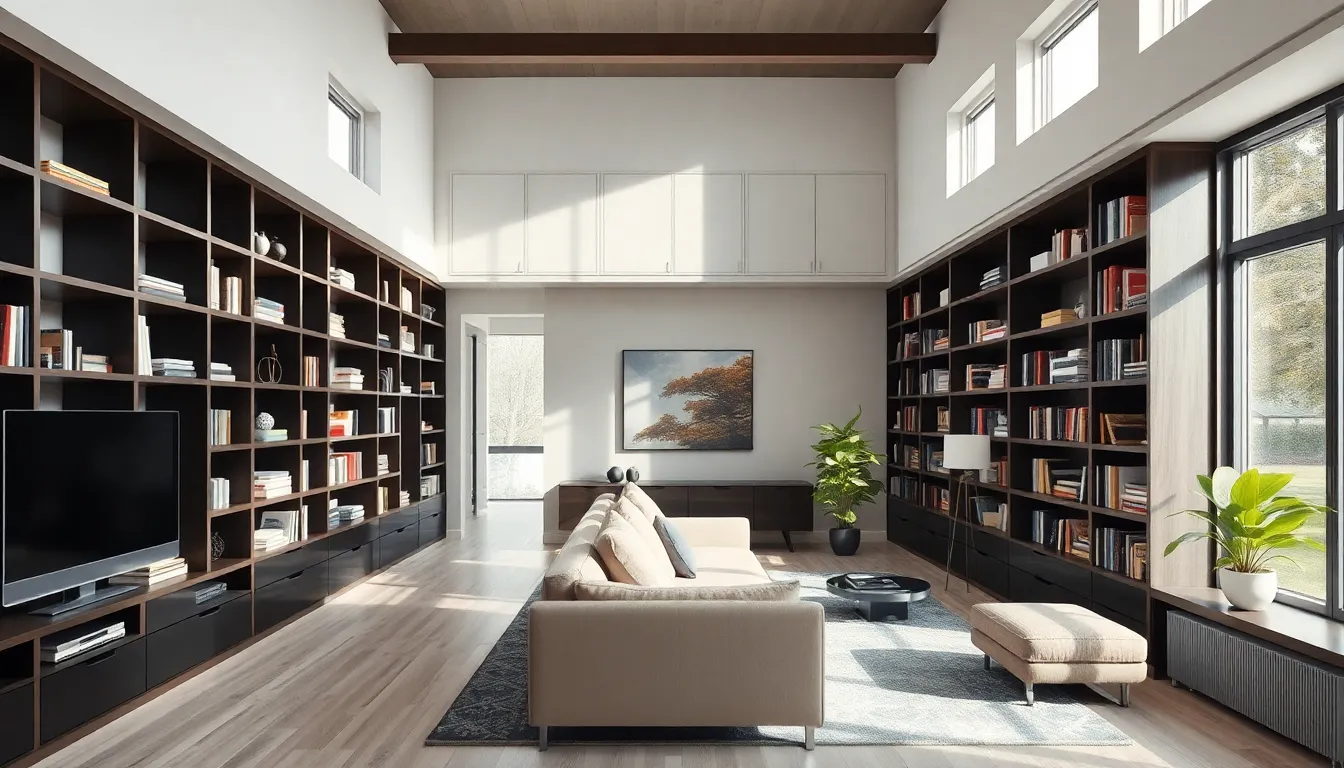
Building upward transforms long living rooms by maximizing storage without sacrificing precious floor space. We’ve found that vertical answers create organized, functional environments while drawing the eye upward to enhance room proportions.
Install Built-in Shelving Units
Built-in shelving units create seamless storage that feels intentionally designed for your exact space. We recommend fitting these units snugly into corners or along walls to provide ample storage without consuming valuable floor area. Custom installations allow you to match existing architectural details, creating a cohesive look that feels original to your home.
Consider floor-to-ceiling units that extend all the way to the ceiling for maximum impact. These installations create dramatic vertical lines that make long rooms feel taller and more balanced. We suggest incorporating adjustable shelves to accommodate items of varying heights, from books and decorative objects to storage baskets and media equipment.
Recessed built-ins work particularly well in long living rooms because they don’t protrude into the walking space. Professional installation ensures proper anchoring and electrical integration if you plan to include built-in lighting or charging stations.
Add Tall Bookcases for Visual Height
Tall bookcases serve as both practical storage and visual anchors that enhance room proportions. We’ve discovered that these units make rooms feel larger and more spacious by drawing attention upward rather than focusing on the room’s length. Strategic placement near seating areas creates natural reading nooks while providing easy access to books and display items.
Select bookcases that reach at least 7-8 feet high to create important vertical impact. We recommend choosing units with varying shelf depths to accommodate different item sizes and create visual interest through layered displays. Mix books with decorative objects, plants, and storage baskets to prevent monotonous arrangements.
Position tall bookcases at room ends or use them to divide different zones within your long living room. This placement creates natural boundaries while maintaining visual flow throughout the space. We suggest using ladder-style units or those with integrated lighting to enhance both functionality and ambiance.
Use Wall-Mounted Cabinets to Save Floor Space
Wall-mounted cabinets maximize storage capacity while keeping floor areas completely clear for furniture and traffic flow. We place these units above existing furniture pieces like sofas or console tables to use often-overlooked vertical space. This approach creates layered storage answers that feel intentional rather than cramped.
Install cabinets at varying heights to create ever-changing visual interest along your walls. We recommend positioning some units closer to eye level for frequently accessed items, while placing others higher for seasonal storage or display purposes. Choose cabinets with doors to hide clutter or open shelving to showcase decorative collections.
Corner-mounted cabinets work exceptionally well in long living rooms because they use awkward spaces that typically remain empty. We suggest selecting units with rounded edges or those specifically designed for corner installation to maximize storage potential. Professional mounting ensures proper weight distribution and prevents damage to walls or stored items.
Consider floating cabinets that appear to hover on the wall for a modern, streamlined look. These units create the illusion of more space while providing substantial storage capacity for media equipment, games, or personal collections.
Choose Furniture That Fits the Room’s Proportions
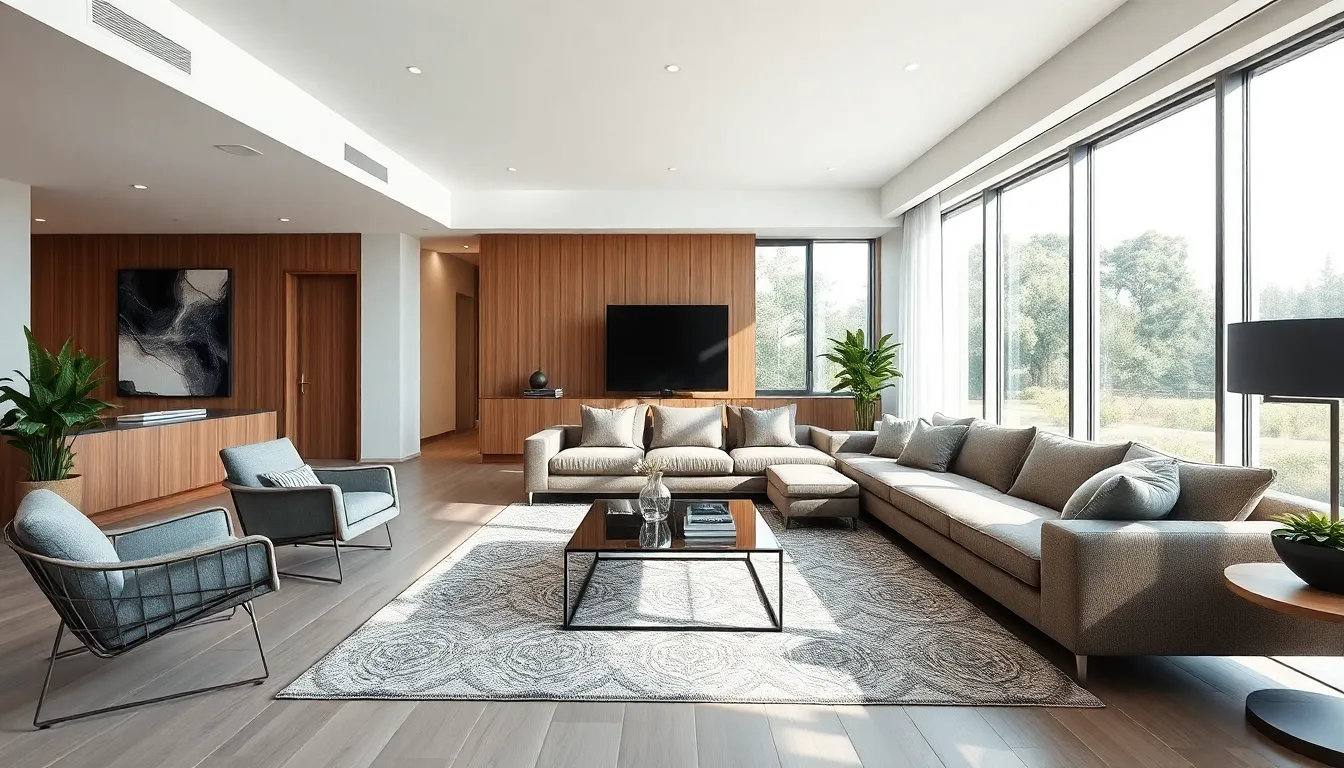
Selecting appropriately sized furniture is crucial for maintaining visual balance in your long living room. We’ll focus on pieces that complement rather than compete with your room’s natural dimensions.
Select Long Sectional Sofas for Seating
Long sectional sofas work beautifully in extended spaces because they create cohesive seating areas that feel intentional rather than scattered. We recommend choosing sectionals that span a important portion of your room’s length while leaving adequate walking space around them.
Position your sectional away from the wall to allow traffic flow behind it. This floating technique prevents the corridor effect that often plagues long rooms and creates a more inviting atmosphere for conversation.
Consider L-shaped sectionals for corner placement, which can help define separate zones within your space. We’ve found that sectionals with modular components offer the flexibility to reconfigure your layout as needed.
Mix sectionals with individual armchairs to create ever-changing seating arrangements. This combination provides better traffic flow while maintaining the visual weight needed to anchor your long space effectively.
Opt for Rectangular Coffee Tables Over Round
Rectangular coffee tables complement the linear nature of long living rooms better than circular alternatives. We choose rectangular pieces because they align with the room’s proportions and provide more surface area for functionality.
Place rectangular coffee tables parallel to your seating arrangement to maintain clear sightlines across the room. This positioning creates visual continuity that enhances the room’s natural flow rather than disrupting it.
Consider using two smaller rectangular tables instead of one large piece if your room accommodates multiple seating areas. This approach allows each zone to have its own functional surface while maintaining proportional balance.
Select coffee tables with storage compartments to maximize functionality without adding visual clutter. We prefer pieces that offer both open display space and concealed storage for maintaining clean lines.
Include Multiple Seating Options for Flow
Multiple seating options enhance both functionality and visual interest in long living rooms. We incorporate various seating types to create flexible arrangements that accommodate different activities and group sizes.
Add swivel chairs to your seating mix because they allow guests to face different areas of the room easily. This flexibility is particularly valuable in long spaces where focal points may exist at opposite ends.
Position accent chairs strategically to guide traffic flow while providing additional seating. We use these pieces to subtly block areas where we want to limit passage, creating more defined pathways through the space.
Include ottomans and benches as versatile seating that can be moved as needed. These pieces serve dual purposes as both seating and surfaces while maintaining the flexibility essential for long room layouts.
Consider window seats or built-in benches along one wall to maximize seating without consuming floor space. This approach works particularly well in narrow long rooms where every square foot matters for maintaining comfortable traffic flow.
Use Color and Pattern to Unify the Space
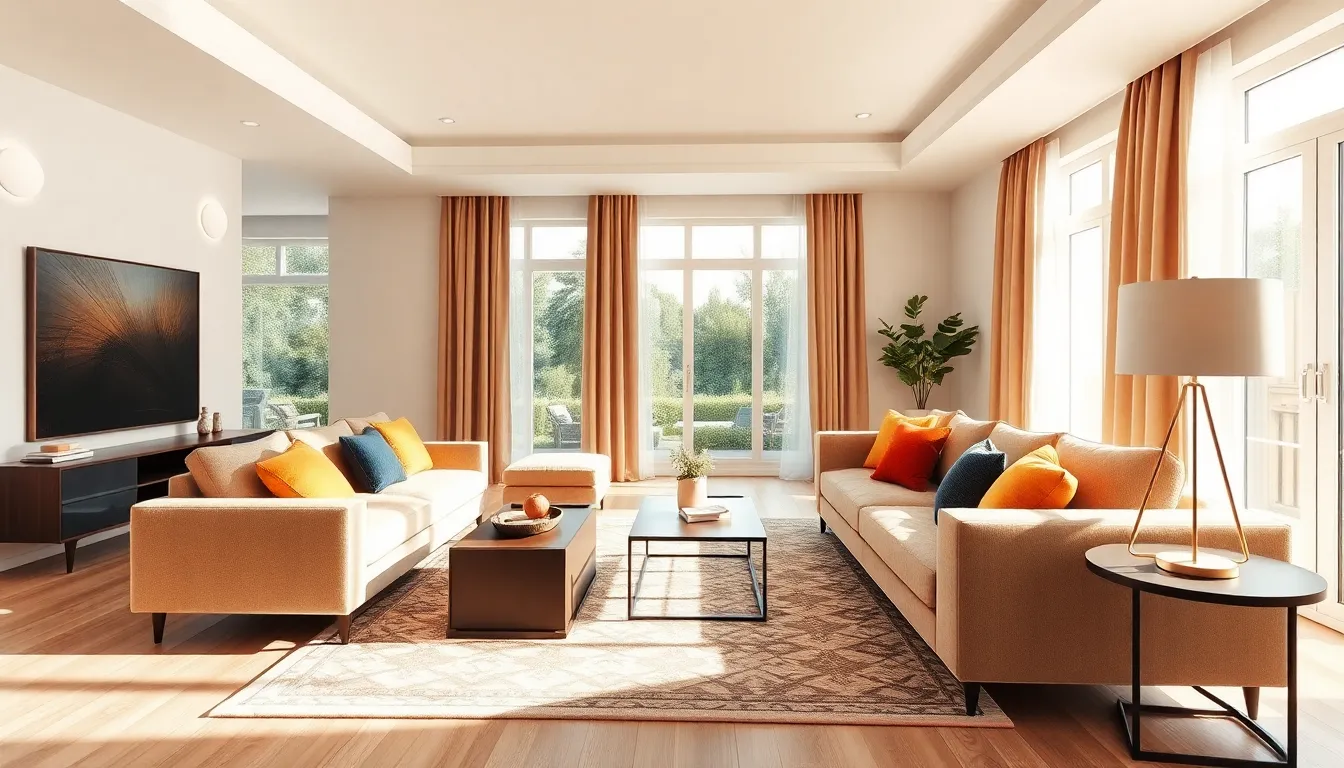
Creating visual unity in a long living room requires strategic use of color and pattern to connect distant areas. This approach transforms what could feel like disconnected spaces into one cohesive design.
Create a Cohesive Color Palette Throughout
Establishing a unified color scheme is essential for tying together different zones in your long living room. We recommend selecting three to four core colors that you’ll repeat throughout the entire space to create visual continuity.
Start with a dominant neutral color for your largest furniture pieces like sofas and major storage units. This creates a stable foundation that won’t compete with your accent colors. Choose a secondary color that complements your neutral base and use it for medium-sized elements such as armchairs or area rugs.
Add two accent colors to bring energy and personality to your space. These work best when distributed evenly across the room’s length rather than concentrated in one area. Consider the natural light variations throughout your long room when selecting colors, as hues may appear different at opposite ends.
Paint color consistency plays a crucial role in unifying your space. Use the same wall color throughout or select colors from the same family to maintain harmony. This technique helps the eye move smoothly from one end of the room to the other without jarring transitions.
Repeat Key Colors in Accessories and Textiles
Strategic repetition of your chosen colors through smaller elements creates rhythm and flow in your long living room. We suggest using accessories and textiles as your primary tools for color distribution since they’re easily adjustable and cost effective.
Select throw pillows in your accent colors and place them on seating throughout the room. Mix different textures and patterns while maintaining the same color family to add visual interest without creating chaos. Position at least one pillow in your key accent color on each major seating piece.
Choose area rugs that incorporate multiple colors from your palette to serve as anchoring elements for each zone. These textile pieces help define separate areas while maintaining color continuity across the space. Layer smaller accent rugs over larger neutral ones to add depth and complexity.
Incorporate your color scheme through window treatments by selecting curtains or blinds that feature your key colors. This technique draws the eye upward and creates vertical connections throughout the room’s length. Use table lamps, artwork frames, and decorative objects in your chosen colors to create visual stepping stones from one end to the other.
Balance Bold Patterns With Neutral Elements
Introducing patterns strategically prevents your long living room from feeling monotonous while maintaining visual harmony. We recommend limiting bold patterns to one or two statement pieces per zone to avoid overwhelming the space.
Choose one large patterned element as your focal point in each area, such as a geometric area rug or a floral accent chair. Support these bold choices with neutral elements like solid colored sofas or plain throw pillows to create breathing room for the eye.
Mix pattern scales throughout your room by combining large prints with smaller ones rather than using patterns of similar size. This creates visual hierarchy and prevents competing elements from fighting for attention. Use your established color palette within all patterns to maintain cohesion even when mixing different designs.
Distribute patterns evenly across your room’s length to create visual balance. Place a striped rug in your seating area and complement it with a subtle geometric throw in your reading nook. This approach ensures that no single area feels too busy or too plain compared to the rest of your long living room.
Add Lighting Layers for Ambiance and Function
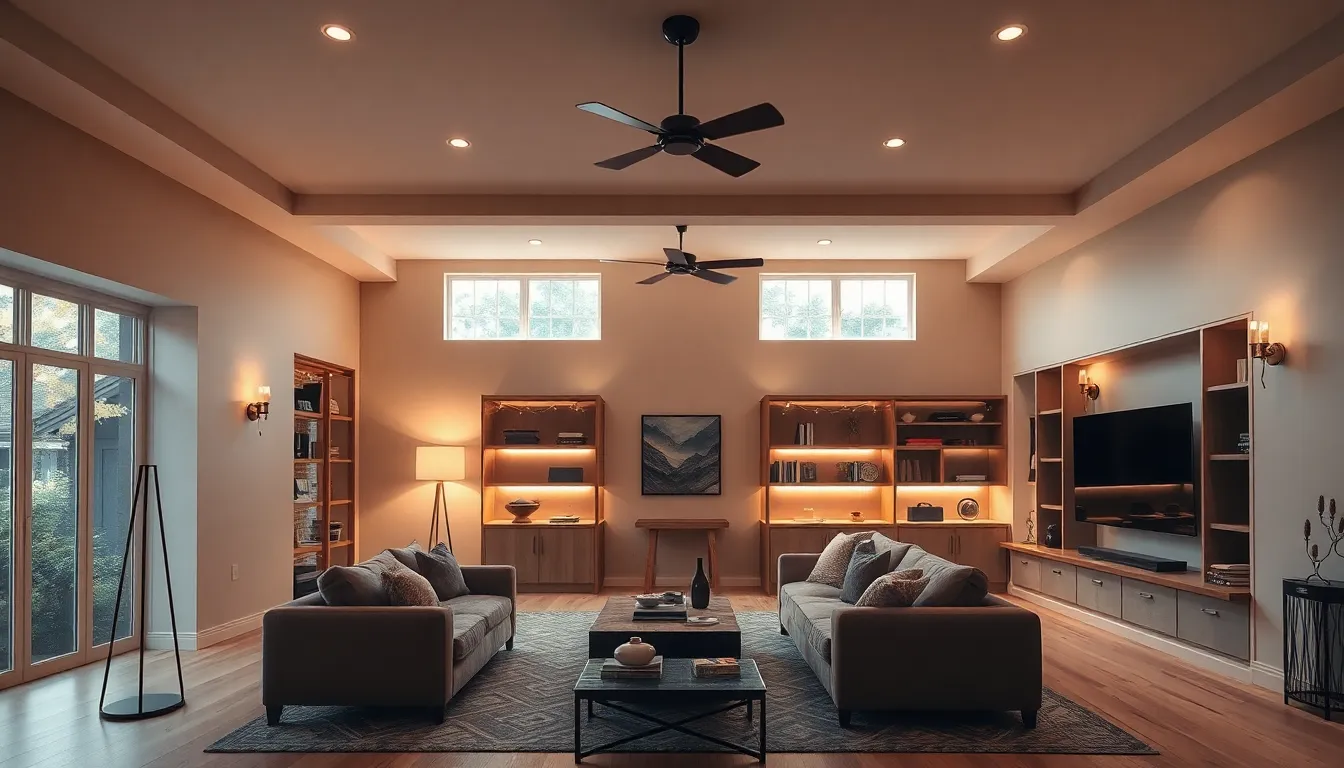
Effective lighting transforms long living rooms from stark corridors into warm, inviting spaces. We’ll create multiple lighting layers to enhance both functionality and atmosphere throughout your room’s length.
Install Multiple Ceiling Light Sources
Ceiling fixtures provide the foundation for your lighting scheme in long living rooms. We recommend installing at least two to three ceiling lights spaced evenly along the room’s length to eliminate dark spots and ensure uniform illumination.
Recessed lights work exceptionally well for long spaces, allowing you to space them 6-8 feet apart for optimal coverage. Track lighting offers another excellent option, giving you the flexibility to direct light toward exact zones or artwork. Pendant lights suspended over distinct areas like dining or reading zones help define separate spaces while contributing to overall illumination.
Consider dimmable ceiling fixtures to adjust brightness levels throughout the day. Installing smart switches allows you to control different ceiling lights independently, creating customized lighting scenes for various activities.
Include Table and Floor Lamps for Task Lighting
Task lighting focuses illumination where you need it most for exact activities. We position table lamps on side tables next to seating areas, providing perfect reading light without disturbing others in different zones.
Floor lamps serve dual purposes in long living rooms, offering both task lighting and height variation that breaks up horizontal lines. Arc floor lamps work particularly well behind sofas, casting light over the seating area without requiring side table space. Adjustable floor lamps near reading nooks or workspaces allow you to direct light precisely where needed.
Buffet lamps on console tables or built-in shelving add both task lighting and decorative elements. These medium-height fixtures bridge the gap between table lamps and floor lamps, creating visual interest at various levels throughout your long room.
Use String Lights or Sconces for Accent Lighting
Accent lighting adds warmth and personality to your long living room’s atmosphere. We install wall sconces at regular intervals along the room’s length to create a cozy, gallery-like ambiance that draws the eye forward.
String lights offer versatile accent lighting options for long spaces. Drape them along built-in shelving, around window frames, or behind furniture to create soft background illumination. LED strip lights hidden behind floating shelves or under cabinets provide subtle accent lighting that highlights architectural features.
Picture lights mounted above artwork serve as both accent lighting and functional illumination for your wall displays. Battery-operated LED puck lights inside glass cabinets or on shelving create beautiful accent lighting without requiring electrical work.
Candles and battery-operated flameless options scattered throughout different zones add intimate accent lighting for evening relaxation. These portable options let you adjust accent lighting based on your current needs and activities.
Incorporate Plants and Greenery for Natural Beauty
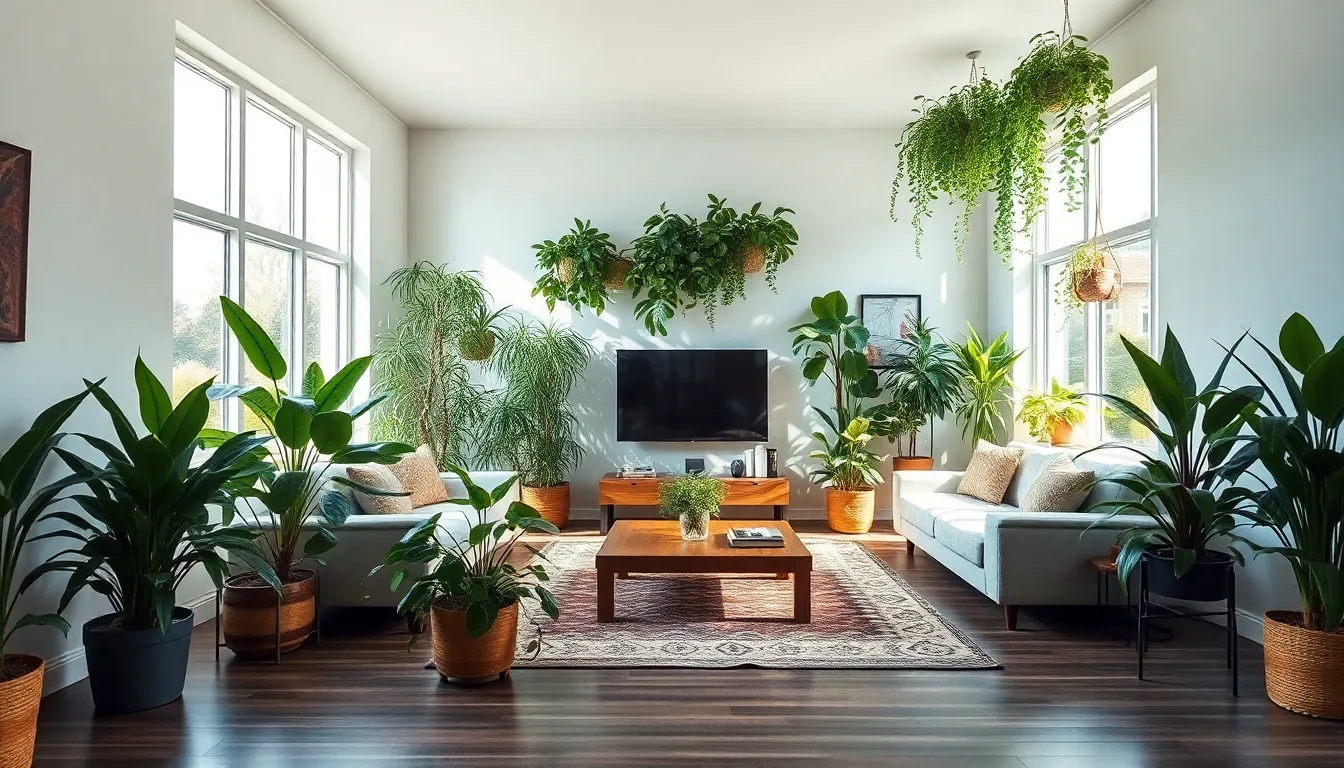
Plants transform long living rooms by adding life and natural beauty while helping to define different zones throughout the space. Greenery creates visual interest and improves air quality, making your elongated room feel more inviting and comfortable.
Place Large Floor Plants in Empty Corners
Umbrella plants excel in long living room corners because they’re fast growing and low maintenance options that can reach 6 ft. or more. These impressive specimens create lush focal points that fill empty spaces without overwhelming the room’s proportions.
Areca palms bring tropical elegance with their long, arching leaves that add movement and texture to corner spaces. They thrive in medium light conditions, making them perfect for corners that don’t receive direct sunlight. We recommend positioning these palms in stylish containers like vintage crocks or terracotta pots to enhance their visual impact.
Strategic placement of large floor plants helps balance the room’s length by creating natural stopping points for the eye. Position plants at varying heights using tall plant stands to maximize vertical space and create layered visual interest throughout your long living room.
Use Hanging Plants to Draw the Eye Upward
String of pearls cascades beautifully from hanging planters with its distinctive pearl shaped leaves, creating dramatic vertical lines that emphasize ceiling height. This drought resistant plant requires minimal care while adding unique texture to high shelves or wall mounted containers.
Pothos and English ivy excel as hanging plants because they cascade gracefully downward, softening harsh architectural lines. Mount these trailing plants on wall mounted shelves at different heights to create a flowing green curtain effect that draws attention upward.
Ceiling hooks and macrame hangers maximize vertical space while keeping floor areas clear for traffic flow. We suggest clustering hanging plants at different heights near windows to create natural privacy screens while maintaining the room’s open feeling.
Create a Green Wall Feature for Visual Interest
Living wall planters transform blank walls into stunning green features using trellises or modular planting systems. Boston ferns and philodendrons work exceptionally well for vertical gardens because they adapt to various light conditions and create lush, full coverage.
Modular systems allow you to customize your green wall’s size and shape to fit your long living room’s exact dimensions. Install these systems on accent walls to create dramatic focal points that break up the room’s length while adding natural beauty.
Maintenance considerations include proper drainage systems and easy access for watering and pruning. We recommend starting with low maintenance plants like pothos or snake plants before expanding to more demanding species, ensuring your green wall remains beautiful with minimal effort.
Conclusion
Long living rooms don’t have to be design challenges – they’re opportunities to create stunning multi-functional spaces. By embracing your room’s natural proportions and implementing strategic zoning we’ve outlined you’ll transform even the most challenging layout into a sophisticated living area.
Remember that success lies in balancing distinct zones while maintaining visual flow throughout the space. Strategic furniture placement proper lighting and thoughtful color coordination work together to create harmony rather than division.
Your long living room has the potential to become the most versatile and impressive space in your home. Start with one or two of our suggested strategies and build from there – you’ll be amazed at how these proven techniques can completely transform your space into something truly spectacular.
Frequently Asked Questions
How do I make my long living room not feel like a hallway?
Create distinct zones using area rugs and strategic furniture placement. Position sofas away from walls to act as natural dividers, and establish focal points at each end of the room. Use console tables behind sofas to create functional separations while maintaining visual flow between areas.
What size area rugs should I use in a long living room?
Choose appropriately sized rugs that define each zone clearly. For seating areas, ensure the rug extends beyond the front legs of sofas and chairs. Use multiple rugs of coordinating colors and textures to create distinct spaces while maintaining visual cohesion throughout the room.
Should I push furniture against the walls in a long living room?
No, avoid pushing all furniture against walls. Instead, float sofas and chairs to create natural room divisions and improve traffic flow. This prevents the corridor effect and makes the space feel more intimate and functional while allowing for better conversation areas.
How can I maximize natural light in my long living room?
Install floor-to-ceiling curtains in lightweight, light-colored fabrics to create height and allow maximum light penetration. Use mirrors strategically to reflect light and create the illusion of width. Paint walls and ceilings in light colors with finishes that effectively reflect light throughout the space.
What type of coffee table works best in long living rooms?
Choose rectangular coffee tables over round ones as they align better with the room’s proportions. The rectangular shape complements the linear nature of long spaces and provides more surface area for functionality while maintaining visual balance with sectional sofas and other furniture pieces.
How do I create focal points in a long living room?
Design balanced focal points at each end to prevent the corridor feeling. Create a media wall with built-in shelving at one end, and establish a reading nook with comfortable seating at the other. Use large artwork as visual anchors and ensure each zone has its own distinct purpose.
What plants work best in long living rooms?
Use large floor plants like umbrella plants and areca palms in corners to create lush focal points. Incorporate hanging plants such as string of pearls and pothos to draw the eye upward. Consider creating a living wall feature with low-maintenance plants to transform blank walls into stunning green features.
How should I approach color schemes in long living rooms?
Use a cohesive color palette with one dominant neutral, one secondary color, and two accent colors distributed evenly throughout the space. Maintain consistent paint colors for harmony and use accessories and textiles to repeat key colors, creating rhythm and visual flow across the entire room.
What lighting strategy works best for long living rooms?
Layer your lighting with multiple ceiling sources like recessed lights or track lighting for uniform illumination. Add table and floor lamps for task lighting, and incorporate accent lighting such as sconces or string lights for warmth. This multi-layered approach creates both functionality and ambiance.
How do I choose the right furniture size for my long living room?
Select long sectional sofas for cohesive seating areas and position them away from walls. Include multiple seating options like swivel chairs and versatile ottomans to enhance functionality. Consider built-in benches or window seats to maximize seating without consuming valuable floor space, especially in narrower rooms.



